Regent Parrot
Regent ParrotPolytelis anthopeplus monarchoides | |
|---|---|
| Kingdom: | Animalia |
| Phylum: | Chordata |
| Class: | Aves |
| Order: | Psittaciformes |
| Family: | Psittacidae |
| Status | |
| World: | Least concern (IUCN Red List 2025) sub-species not assessed |
| Australia: | Vulnerable, (EPBC Act listed) |
| Victoria: | Vulnerable (FFG Threatened List 2025) |
| New South Wales: | Endangered (OEH 2025) |
| South Australia: | Vulnerable |
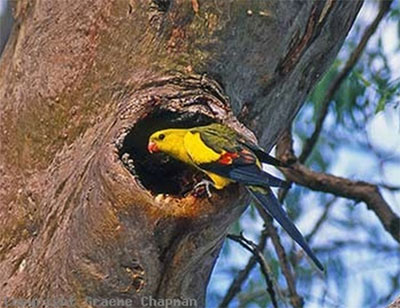
The Regent Parrot Polytelis anthopeplus occurs as two isolated sub-species in Australia.
-
Polytelis anthopeplus anthopeplus - found in south-west Western Australia.
-
Polytelis anthopeplus monarchoides - the eastern subspecies confined to areas of mallee and riverine woodlands along the Murray, Darling and Wimmera Rivers in the Victoria, New South Wales and South Australia.
The adult male Regent Parrot has a general yellow appearance with the tail and outer edges of the wings being dark blue-black. It has yellow shoulder patches and a narrow red band crosses the centre of the wings and yellow underwings. Its back and inner wing coverts are dark olive-green. Adult females and juveniles are predominately a dull olive-green with more subdued markings than the male.
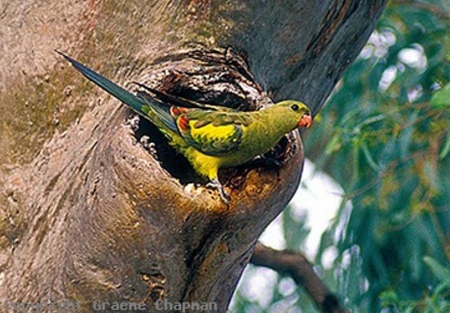
Distribution in Victoria
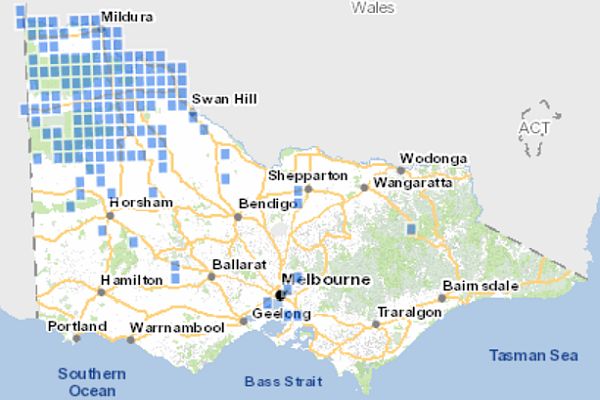
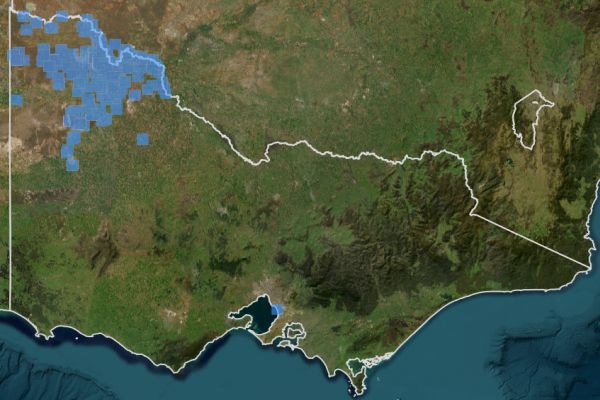
Within Victoria, the Regent Parrot is found along the Murray River and associated National Parks and conservation reserves. It is also found in the Wimmera River Drainage Basin from Lake Hindmarsh up into the Wyperfeld National Park.
The Regent Parrot (eastern subspecies) occurs in south-eastern Australia (lower Murray-Darling basin region of SA, NSW & Vic). The population is estimated to be no more than 1,500 adult breeding pairs (Robertson & Hurley 2015, Garnett et.al. 2011). In the Wimmera River drainage basin the breeding population could be fewer than 350 breeding pairs which includes 235 nests in Wyperfield National Park (Garnett & Crowley 2000). Numbers have declined at many locations since the 1990's (Garnett et.al. 2011) see above map which demonstrates a reduction in the area occupied.
Ecology & Habitat
Habitat
The Regent Parrot (eastern subspecies) habitat comprises River Red Gum Eucalyptus camaldulensis and sometimes Black Box Eucalyptus largiflorens communities for nesting and large diverse blocks of mallee woodland, particularly Red Mallee Eucalyptus socialis and Yellow Mallee Eucalyptus incrassata for feeding. Nest trees are usually located within close proximity to water but variable up to >200 metres from water (GHD 2009) and within 20 km of mallee foraging habitat.
The Regent Parrot is found in pairs or small flocks. Regent Parrots are seen in the Murray Sunset National Park at all times of the year. Non-breeding adults and immature birds rely on areas of mallee away from the Murray River floodplain throughout the year.
Nesting
The main breeding season is between September to December. Nest trees are typically mature, senescent or dead with a height of 30m, 1.66m DBH and a crown diameter of 17m. Hollows used for nesting average about 21m above the ground (Burbidge 1985; Webster 1991). Characteristic measurements are small diameter openings averaging 10 cm high x 9 cm wide and deep hollows to nest chamber averaging 1 m deep (Hurley 2010). See nest hollows fact sheet
Eggs are laid approximately 14 days after the initial courtship display (Burbidge 1985; Webster 1991). The female incubates 3-6 eggs for a period of 21 days whilst the male feeds her in the nesting hollow by regurgitating food (Webster 1991). The young are fed by both parents or cooperatively fed by a group of adult birds (Beardsell 1985).
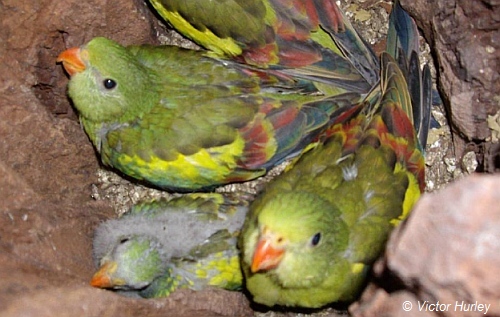
Brood of four Regent Parrots from a clutch of five eggs. (Photograph by V.G. Hurley, 2008)
Movement
Regent Parrots move between feeding and nesting areas. They rely on important features in the landscape such as habitat corridors along roadsides, river frontages and across paddocks with remnant trees which link the landscape. These are important features in the landscape for Regent Parrots as they do not readily fly across areas with no cover.
When movements occur over open fallowed paddocks or cereal crops, Regent Parrots fly very low (1-2m high) and fast in a more or less direct line toward remnant vegetation. The vast majority of movements occur early in the morning with few movements occurring after 11.15 hrs (Sluiter 2007). It has also been observed that 80% of the movement associated with nesting occurs between 7am and noon (Hurley 2009).
Studies have found Regent Parrots readily use almond groves as movement corridors. There has been a 10-fold increase in almond groves the Robinvale area between 2003 to 2013 to approx. > 20,000 ha (CSU 2013).
Feeding
The Regent Parrot has been recorded eating the seeds, fruits or buds of over 40 plant species (Webster 1991). Foraging activities have predominately been observed in mallee, although food may also be obtained from vineyards, orchards, cereal crops and riparian woodlands (Burbidge 1985). They will also feed on spilt grain on roads (DEC 2005) and are known to forage in almond crops (CSU 2013), although the overall impact would be low considering the vastness of almond crops and the low numbers of Regent Parrots.
Threats to Regent Parrots
The most serious threats are;
Loss of habitat; clearing, grazing, harvesting and degradation of River Red Gum and mallee vegetation, especially within 20km of major rivers and along flight paths. Loss of habitat disrupts movement, may increase the risk of predation, limit access to suitable foraging habitat or reduce foraging efficiency to the point where nesting habitat becomes unsuitable or breeding success is affected.
Salinisation; rising groundwater impacts on the health of vegetation causing loss of breeding and foraging habitat.
Drought; lack of water flowing into Lake Albacutya is affecting the surrounding vegetation, in particular dieback in River Red gums which is an important feed and nesting tree of the parrot. In addition Regent Parrots require a permanent water supply for drinking water.
Competition for nest hollows; competition with honey bees can result in the abandonment of nest sites.
Fire; porly planned fuel reduction burns may negatively impact upon nesting and/or foraging habitats.
Road kill; birds may feed on spilt grain on roadsides and thus be at risk of being struck by vehicles.
Poisoning; pesticide application on grains.
Illegal bird trade, involving trapping, egg collecting and removal of chicks from nests by poachers. These activities may result in the destruction of nest hollows and can impact upon populations through the loss or death of individual birds.
Agricultural control; through shooting by orchardists or unintentional poisioning when baiting and trapping of vermin, eg. Oat baits for rabbits are not target specific and have resulted in substantial population losses.
Conservation of the Regent Parrot in Victoria
Key land managers
Parks Victoria
- Annuello Flora & Fauna Reserve
- Hattah - Kulkyne National Park
- Lake Albacutya Park
- Murray - Kulkyne Park
- Murray River Reserve
- Murray - Sunset National Park
- Wandown Flora & Fauna Reserve
- Wyperfeld National Park
Department of Environment, Land, Water & Planning
- Mildura Forest management area - Riverine State forest
- Outlet Creek Public Land Water Frontage
- Environmental flows to maintain tree health for known Regent Parrot breeding colonies.
Mallee Catchment Management Authority
- The Living Murray project
- Victorian Murray Floodplain Restoration Project
North Central CMA
- Victorian Murray Floodplain Restoration Project
Wimmera CMA
- Environmental flows to Lake Albacutya
Key Local Government Areas in Victoria
- Mildura Rural City
- Swan Hill Rural City Council
- Yarriambiack Shire
- Hindmarsh Shire
- Buloke Shire
- Loddon Shire
Private landholders
- areas of remnant vegetation containing nesting habitat
- farmland containing habitat corridors.
Management actions
- Conduct surveys to determine abundance/extent within suitable habitat in areas managed by Parks Victoria.
- Develop measures to implement park, reserve or land management plans to ensure visitor areas are kept away from breeding areas.
- Protect River Red Gum habitat and individual trees used by breeding colonies from fire.
- Installation of nest boxes at selected locations (provided they meet standards suitable for occupation).
- Provide environmental flow to assist habitat along the Wimmera River, Hattah Lakes in Hattah-Kulkyne National Park and along the Murray to support Red Gum vegetation.
Nest box construction
The recommended nest box plan is based on measurements taken from 35 known Regent Parrot nests in Victorian River Red Gums. Nest boxes must be constructed from hardwood and preferably from River Red Gum logs. The base of the nest chamber must be lined with 50 mm thick layer of activated charcoal covered with a further 50 mm thick layer of frass (termite dung and other detritus) from existing decaying River Red Gum logs on site. The lid must be hinged to allow inspection and to be secured via a rare earth magnet and metal attachment plate. The lid must be able to open to at least 90 degrees (Hurley 2014).
Poorly designed thin plywood nest boxes provide no thermal insulation at all and internal temperatures equal external temperatures at all times. Parrots nesting in these boxes would need to cope with daily fluctuations in temperature of up to 25 ⁰C, whereas for those in natural cavities the maximum daily variation is 12⁰ C. This, not surprisingly, because the natural cavities are more thermally stable and likely to remain more attractive to Regent Parrots in the extremes of Victoria’s Mallee region (Robertson & Hurley 215).
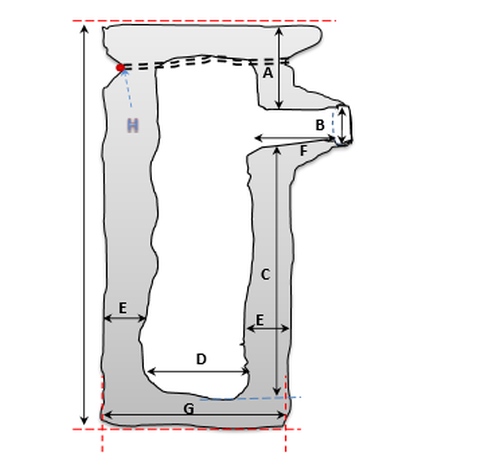
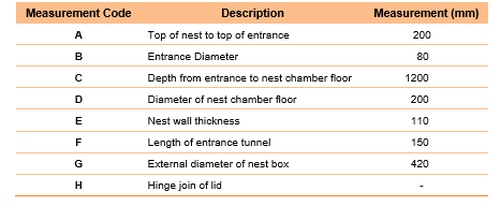
Adapted from (Hurley 2014)
Regent Parrort nest hollows fact sheet
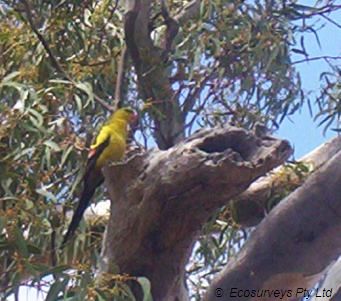
Research
In 2009 a population monitoring protocol for monitoring breeding colonies at two locations along the Murray River was completed for the Mallee Catchment Management Authority (GHD 2009).
There have been numerous surveys conducted to measure breeding success e.g. Note these reports have not been linked here due to the sensitive nature of site locations.
- 1985 Victoria & New South Wales and South Australia Murray River surveys (Burbidge)
- 2001 Results of selected site surveys for Regent Parrot colonies Piambie-Nangiloc Vic. (Webster)
- 2003 Results of Regent Parrot nest colony surveys Piambie SF to Lambert's Is FR, Vic. (Webster)
- 2005 Overview of survey results for Regent Parrot nesting colonies in Victoria.(Webster)
- 2006 Results of Regent Parrot breeding colony surveys Walpolla Is, Victoria (Webster)
- 2006 Observations of Regent Parrot spring flight path and corridor usage Wemen, Victoria (Sluiter)
- 2007 Regent Parrot nest colony survey Yungera SF, Vic & Peacock Ck FR, NSW (Webster)
- 2007 Observations of Regent Parrot spring flight path and corridor usage Wemen Victoria (Sluiter)
- 2008 Regent Parrot nest activity report, Wyperfeld NP (Hurley)
- 2008 Regent Parrot Non-breeding season survey report - Ouyen area (Sluiter)
- 2009 Nest activity patterns of Regent Parrots at Outlet Creek, Wyperfeld National Park (Hurley)
- 2009 Regent Parrot Non-breeding season survey report - Ouyen area (Sluiter)
- 2014 Regent Parrot hollow usage in Hattah-Kulkyne NP - 2013 (Hurley & Robertson)
- 2010 Regent Parrot Non-breeding season survey report - Ouyen area (GHD)
- 2013 Regent Parrot studies regarding Managing Agricultural Landscapes to Maximise Production and Conservation Outcomes (Charles Sturt University)
- 2015 Regent Parrot hollow usage in Hattah-Kulkyne NP - 2014 (Robertson & Hurley)
Between 2009 - 2013 Charles Sturt University undertook research to (1) identify and examine the relationships between key habitat and food resources of Regent Parrots in landscapes, and (2) examine the foraging behaviour of birds in agricultural landscapes to determine the potential for species to provide ecosystem services (e.g. insectivores foraging in orchards for insect pests) or contribute to crop damage (e.g. parrots consuming fruit).
References & Links
Beardsell C., (1985) The Regent Parrot. A report on the nest site survey in south-eastern Australia. Australian National Parks and Wildlife Service, Report Series No.1, Canberra, ACT.
Burbidge A. H. (1985) The Regent Parrot. A report on the breeding distribution and habitat requirements along the Murray River in south-eastern Australia. Australian National Parks and Wildlife Service, Report Series No. 4, Canberra, ACT.
CSU (2013) Charles Sturt University, Managing agricultural landscapes to maximise production and conservation outcomes: The case of the Regent Parrot 2013. Dr Peter Spooner School of Environment and Information Sciences.
OEH (2025) New South Wales Office of Environment and Heritage Threatened Species profile - Regent Parrot, New South Wales Government.
FFG Threatened List (2025) FFG Threatened List, (Flora and Fauna Guarantee Threatened List) , Department of Energy, Environment and Climate Action (DEECA).
Garnett S., Szabo, J., Dutson, G. (2011) The Action Plan for Australian Birds 2010. CSIRO Publishing, Melbourne. Subspecies Conservation Summary Regent Parrot (eastern) pdf
Garnett S. & Crowley G. (2000) The Action Plan for Australian Birds 2000: Recovery Outline - Regent Parrot (eastern) http://www.environment.gov.au/biodiversity/threatened/publications/action/birds2000/pubs/regent-parrot-e.pdf (PDF -30KB)
GHD (2009) A population monitoring protocol for known Regent Parrot (Polytelis anthopeplus monarchoides) breeding colonies at two locations along the Murray River - Final Report . September 2009. Report to Mallee Catchment Management Authority. GHD, 57 Orange Ave. Mildura 3500.
Hurley (2009) Results of nest site monitoring of active Regent Parrot (Polytelis anthopeplus monarchoides)
nests, in the Outlet Creek system, Wyperfeld NP, during spring 2008. Department of Sustainability and Environment, Mildura.
Hurley, V. G. (2014). “Regent Parrot (Polytelis anthopeplus monarchoides) tree hollow usage in Hattah-Kulkyne National Park, 2013.” An unpublished report to the Mallee Catchment Authority by the Department of .Environment and Primary Industries, Mildura.
(IUCN Red List 2025) BirdLife International. 2024. Polytelis anthopeplus. The IUCN Red List of Threatened Species 2024: https://dx.doi.org/10.2305/IUCN.UK.2024-2.RLTS.T22685078A254011855.en. Accessed on 16 April 2025.
Robertson, P. and Hurley, V.G. (2015). “Regent Parrot hollow usage in Hattah-Kulkyne National Park – 2014.” An unpublished report to the Mallee Catchment Authority by the Department of Environment, Land, Water & Planning, Mildura and Wildlife Profiles Pty. Ltd.
Webster R. (1991) The biology and management of the Regent Parrot Polytelis anthopeplus anthopeplus in NSW. Species management report number 4. NPWS, Hurstville, NSW.
Sluiter (2007) Dr. Ian Sluiter Observations on Spring Regent Parrot Movements at Wemen Between 1998 and 2007, Ogyris Ecological Report No. 2007/20
VBA (2024) Victorian Biodiversity Atlas, Department of Energy, Environment and Climate Action (DEECA), Victoria.
VVB (2024) Visualising Victoria's Biodiversity map portal.
More Information
Regent Parrot - Species profile & threats database, Department of Climate Change, Energy, the Environment and Water. Accessed October 2024
National Recovery Plan - Regent Parrot (eastern sub-species) 2011
South Australia Regent Parrot Recovery Team
Please contribute information regarding Regent Parrot in Victoria - observations, images or projects. Contact SWIFFT

